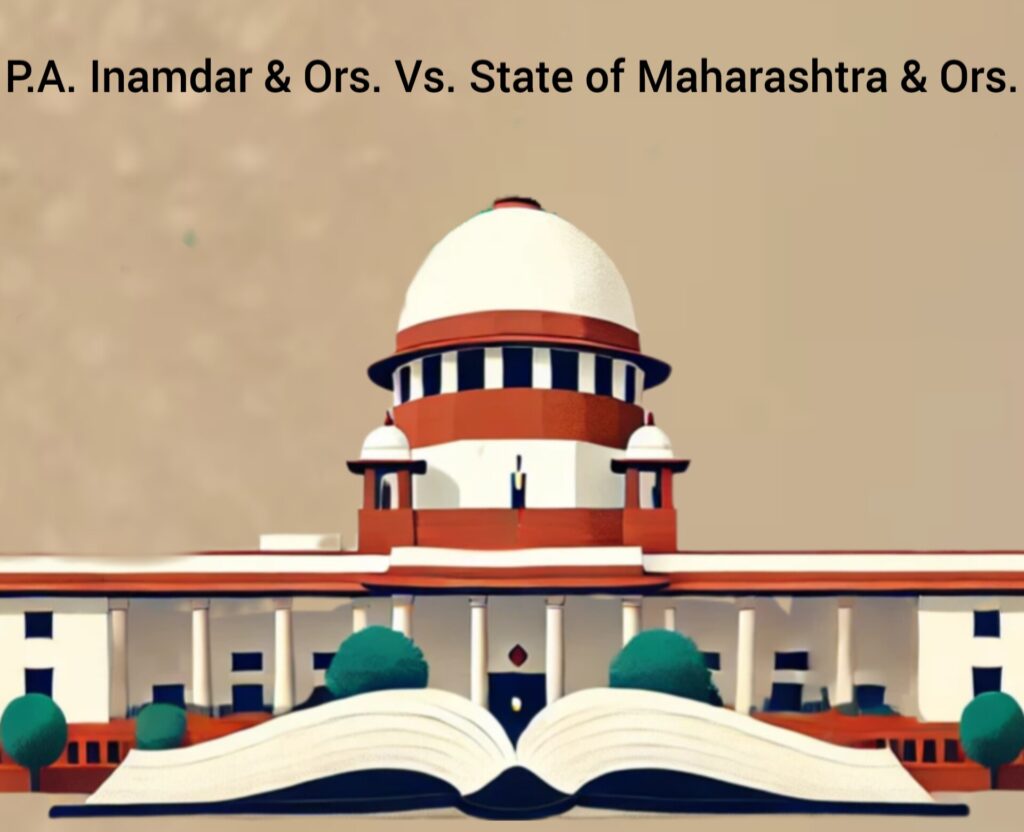Anushri Joshi
CASE NAME – P.A. Inamdar & Ors. Vs. State of Maharashtra & Ors.
CITATION – (2005) 6 SCC 537.
DECIDED ON – August 12, 2005.
CORAM – Hon’ble Chief Justice R.C. Lahoti, Justices Y.K. Sabharwal, D.M. Dharmadhikari, Arun Kumar, B.N. Srikrishna, P.K. Balasubramanyan, and S.H. Kapadia.
PETITIONER – P.A. Inamdar & Others.
RESPONDENT – State of Maharashtra & Others.
PROVISIONS INVOLVED – Articles 19(1)(g), 21, 29, 30, and 41 of the Constitution of India; Section 12A of the Maharashtra Unaided Private Professional Educational Institutions (Regulation of Admissions and Fees) Act, 2003.
Introduction
The case P.A. Inamdar vs. State of Maharashtra is a critical milestone in Indian constitutional law concerning the autonomy of private. unaided educational institutions, particularly in matters of admissions and fee structures. The case addressed the scope of the state’s power to regulate private. unaided institutions and their right to autonomy in the administration of professional courses like engineering and medicine. This case further built upon the precedent set in T.M.A. Pai Foundation vs. State of Karnataka (2002), dealing with the balance between institutional freedom and state regulation.
Facts in Brief
P.A. Inamdar and others represented a group of private. unaided professional institutions in Maharashtra. These institutions challenged a law passed by the Maharashtra government that imposed a regulatory framework for admissions and fee structures in private institutions, including setting up a Common Entrance Test (CET) for admissions and restricting fees to prevent profiteering. The petitioners contended that these regulations were unconstitutional, violating their rights under Articles 19(1)(g) and 30 of the Constitution, which guarantee the right to establish and administer educational institutions without state interference.
The State argued that regulation was necessary to ensure fairness and transparency in admissions and to prevent exploitation through exorbitant fees. The case presented the question of how far the state could go in regulating private unaided institutions, particularly minority institutions, without infringing upon their autonomy.
Issues Raised
1. Whether the state can regulate admissions and fees in private, unaided professional institutions, including minority institutions?
2. Whether the decision in the T.M.A. Pai Foundation case provided full autonomy to private institutions regarding admissions and fees?
3. Can unaided institutions be compelled to adopt a state-regulated admission procedure like the CET?
4. What is the extent of judicial scrutiny required to balance institutional autonomy with ensuring non-exploitative practices?
Arguments from the Petitioners
Senior Advocate Harish Salve, representing the petitioners, argued the following points:
• The autonomy to manage admissions and fees is a fundamental right under Article 19(1)(g) and Article 30 of the Constitution, which guarantees the right to establish and administer educational institutions.
• Private unaided institutions, particularly minority institutions, do not receive state funds and should not be subjected to excessive state regulation.
• While the petitioners agreed on the need to prevent profiteering, they argued that fee determination should remain within the institution’s purview, provided the fees are reasonable.
• The petitioners also contended that the T.M.A. Pai Foundation judgment had recognized the autonomy of private institutions, and the Maharashtra government’s law was inconsistent with that precedent.
Arguments from the Respondents
The State of Maharashtra, in defense, made the following points:
1. The State has a duty to regulate admissions and fees to prevent exploitative practices like capitation fees and ensure that education remains merit-based and equitable.
2. The CET was defended as a fair mechanism to ensure equal access to professional education for students from diverse socio-economic backgrounds.
3. The State argued that private. unaided institutions serve a public function and must therefore adhere to public policies that promote fairness and transparency.
4. The government further asserted that the rights under Article 30 for minority institutions do not exempt them from reasonable regulations that ensure access to quality education for all sections of society.
Analysis of the Judgment
The Supreme Cour sought to balance the autonomy of private unaided institutions and the state’s role in regulating education to ensure fairness and transparency.
1. Admissions: The Court ruled that private unaided institutions, both minority and non-minority, have the right to admit students of their choice, but such admissions must be based on merit to maintain equity and fairness. While the state can impose a regulatory mechanism to ensure a merit-based system, institutions are not compelled to follow the state’s CET if their own admission process is transparent and merit-based.
2. Fee Regulation: The Court affirmed that private unaided institutions have the right to determine their fees, but these fees must be reasonable and non-exploitative. It upheld the state’s authority to establish committees to oversee fee structures and prevent exorbitant charges and profiteering.
3. T.M.A. Pai Foundation case : The Court clarified that the T.M.A. Pai Foundation judgment had granted significant autonomy to private unaided institutions but noted that this autonomy is subject to reasonable restrictions. The institutions cannot hide behind autonomy to engage in commercialization or impose excessive financial burdens on students.
4. Minority Rights under Article 30: The Court held that minority institutions do have special rights under Article 30, but these rights are not absolute. The State can impose reasonable restrictions to ensure that such institutions do not engage in exploitative practices, provided these restrictions do not affect the minority character of the institution.
Conclusion
The judgment in P.A. Inamdar vs. State of Maharashtra reaffirmed the autonomy of private unaided educational institutions, including minority institutions, regarding admissions and fee structures. However, this autonomy is not unfettered and is subject to reasonable state regulation aimed at preventing exploitation and ensuring merit-based admissions. The decision struck a delicate balance between institutional freedom and the state’s responsibility to prevent commercialization in education. The case has had a profound impact on the regulation of private education in India, influencing both policy-making and subsequent judicial interpretations of the autonomy of educational institutions. The ruling ensures that institutions exercise their autonomy within a framework of fairness and equity, benefiting both the institutions and the students.
Click here to access the order

